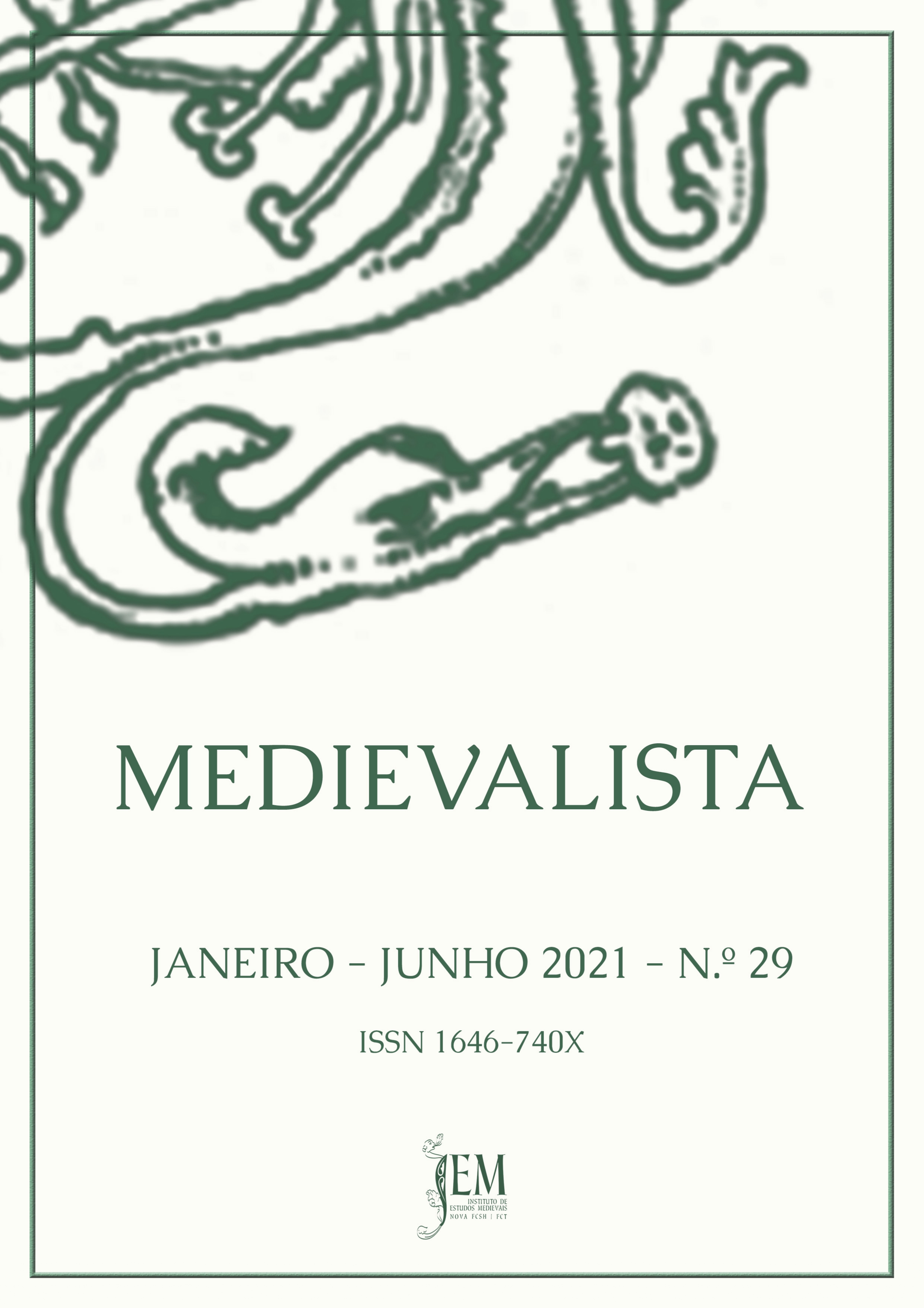Os cem olhos do pavão: Representações da ave na Idade Média e suas origens simbólicas
DOI:
https://doi.org/10.4000/medievalista.3908Palabras clave:
Bestiário, Simbolismo, Pavão, Idade Média, ImaginárioResumen
O pavão é considerado um dos mais bonitos animais da natureza. Essa beleza, no que diz respeito ao imaginário, torna-se elemento-chave nas narrativas e nas artes que associam o pavão com as divindades hindus e budistas, com o orgulho e com a vaidade. Este artigo busca apresentar de que forma os simbolismos do pavão foram transmitidos e adaptados, desde a Índia Antiga até a Europa Medieval, onde a ave figurou na criatividade cristã como emblema da imortalidade de Cristo e dos pregadores da Igreja, acompanhando também narrativas hagiográficas e imagens bíblicas.
Referências bibliográficas:
Fontes manuscritas
Aberdeen, University, Bestiário de Aberdeen, Ms. 24. Disponível em https://www.abdn.ac.uk/bestiary/.
Library, Medicaen-Laurentian Library, Syriac Orthodox Resources – Miniatures from the Rabbula Gospels. Ms. Plut. I, 56. Disponível em http://sor.cua.edu/Bible/RabbulaMs.html.
Fontes impressas
ARISTÓTELES – History of Animals [Em linha]. Ed. Richard Cresswell, Project Gutenberg. (Consultado a 7 julho 2019). Disponível em http://www.gutenberg.org/files/59058/59058-h/59058-h.htm.
BARBER, Richard (Ed.) – Bestiary. Being an English Version of the Bodleian Library, Oxford, MS Bodley 764. Woodbridge: Boydell, 1999.
Bíblia de Jerusalém. São Paulo: Ed. Paulus, 2002.
CLARK, Willene B. (ed.) – The Medieval Book of Birds: Hugh of Fouilloy’s Aviarium. (Medieval & Renaissance Texts and Studies, 80). Binghamton, New York: State University of New York, 1992.
ELIANO, Cláudio – On The Nature Of Animals [Em linha]. Ed. A. F. Scholfield, 1958. (Consultado a 7 julho 2019). Disponível em http://www.attalus.org/translate/animals5.html.
ESOPO – Fábulas. Ed. Antônio Carlos Vianna. Porto Alegre: L&PM Editores, 1997.
ISIDORO DE SEVILHA – Etimologias. Ed. Stephen A. Barney; W. J. Lewis; J. A. Beach; Oliver Berghof – The Etymologies of Isidore of Seville. Cambridge: Cambridge University Press, 2006.
JACOPO DE VAZARRE – Legenda Áurea. Ed. Hilário Franco Júnior. São Paulo: Companhia das Letras, 2011.
MARCO POLO – The Travels of Marco Polo [Em linha], vol. 2. Ed. Henry Yule; Henri Cordier, Cap. XVIII. (Consultado a 7 julho 2019). Disponível em http://www.gutenberg.org/cache/epub/12410/pg12410-images.html.
PLINY THE ELDER – The Natural History [Em linha]. Ed. John Bostock, 1885. (Consultado a 7 julho 2019). Disponível em: http://www.perseus.tufts.edu/hopper/text?doc=Perseus%3Atext%3A1999.02.0137%3Abook%3D8%3Achapter%3D50.
SANTO AGOSTINHO – A Cidade de Deus. Parte II. São Paulo: Vozes de Bolso, 2014.
SANTO ANTÓNIO – Sermão do Primeiro Domingo da Quaresma. Ed. Henrique Pinto Rema – Santo António: Obras Completas. Porto: Lello & Irmão, 1987.
RAZI, Sharif (Trad.)– Nahjul Balagha: Peak of Eloquence. [Em linha]. DuasPublishing Project (Consultado a 7 julho 2019). Disponível em https://www.al-islam.org/nahjul-balagha-part-1-sermons/sermon-165-allah-has-provided-wonderful-creations#about-peacock.
Estudos
ALLISON, Christine – “YAZIDIS i. GENERAL”. in Encyclopædia Iranica [Em linha]. (Consultado a 7 julho 2019). Disponível em http://www.iranicaonline.org/articles/yazidis-i-general-1.
ANĐELKOVIĆ, Jelena; ROGIĆ, Dragana; NIKOLIĆ, Emilija – “Peacock as a sign in the late antique and early christian art”. Archeology and Science 6 (2010), pp. 231- 268.
BEER, Robert – The Handbook of Tibetan Buddhist Symbols. London, Chicago: Serindia, 2003.
BERNARD, Meehan – The Book of Kells: An Illustrated Introduction to the Manuscript in Trinity College Dublin. New York: Thames and Hudson, 1994.
CAVALLINI, Andrea – La penna del pavone: Bibbia ed esegesi in Gioivanni Scoito Eriugena. Roma: Città Nuova, 2016.
CHEVALIER, Jean; GHEERBRANDT, Alain – Dictionary of Symbols. Paris: Penguin Reference, 1982.
CHEVALLIER, Jim (Ed.) – How To Cook A Peacock: Le Viandier: Medieval Recipes From The French Court. California: Chez Jim, 2008.
CHOSKYI, Jampa – “Symbolism of Animals in Buddhism”. Revista Buddhist Himalaya [Em linha] 1/1 (1988). (Consultado a 7 julho 2019). Disponível em: http://ccbs.ntu.edu.tw/FULLTEXT/JR-BH/bh117490.htm.
COOPER, Jean C. – An Illustrated Encyclopaedia of Tradicional Symbols. London: Thames & Hudson, 1978.
COTTERELL, Arthur – A Dictionary of World Mythology. New York: Perigee Book, 1979.
DALAL, Roshen – Hinduism: An alphabetic guide. New Dhéli: Penguin, 2011.
DE JONG, Albert – “The Peacock and the Evil One”. in ALLISON, Christine; JOISTEN-PRUSCHKE, Anke; WENDTLAND, Antje – From Daena to Din: Religion, Kultur und Sprache in der iranischen Welt. Wiesbaden: Harrassowitz Verlag, 2009, pp. 303-320.
DE LONGUYON, Jacques – Una redazione latina inedita dei voti del Pavone. A cura do Vincenzo Licitra. Spoleto: Centro italiani di studi sull'alto Medioevo, 1961.
DIXON-KENNEDY, Mike – Encyclopedia of Grego-Roman Mythology. Santa Bárbara: ABC-CLIO, 1998.
EDMONDS, John Maxwell (Ed.) – The Fragments of Attic Comedy. Vol. II. Leiden: E. J. Brill, 1959.
FRIEDMAN, John B. – “Peacocks and Preachers: Analytic Technique in Marcus of Orvieto’s Liber de moralitatibus, Vatican lot. MS S93S”. in CLARK, Willene B.; McMUNN, Meradith T. – Beasts and birds of the Middle Ages. Philadelphia: University of Pennsylvania Press, 1989, pp. 179-196.
FURLANI, Giuseppe – Gli adoratori del pavone: I Yezidi: i testi sacri di una religione perseguitata. Milano: Joovence, 2016.
JACKSON, Christine E. – Peacock. London: Reaktion Books, 2016.
KANG, Kyu-suk – “The Peacock”. Journal of Symbols & Sandplay Therapy 4/1 (2013), pp. 35-43.
LEO, Dominic – Images, Texts, and Marginalia in a "Vows of the Peacock" Manuscript. New York: Brill, 2013.
LOTHER, Helmut – Der Pfau in der altchristlichen Kunst. Leipzig: Dieterich, 1929.
LUDVIK, Catherine – Sarasvati, Riverine Goddess of Knowledge: From the manuscript-carrying Vina-player to the Weapon-wielding Defender of the Dharma. Leiden, Boston: Brill's Indological Library, 2007.
REIMBOLD, Ersnt Thomas – Der Pfau: Mythologie und Symbolik. Muenchen: Callwey, 1983.
RODRIGUES, Alessandro Pereira – Apício, De Re Coquinaria I-III: Introdução, tradução e notas. Rio Grande do Sul: Universidade Federal, 2010. Trabalho de Conclusão de Curso. (Consultado a 7 julho 2019). Disponível em https://lume.ufrgs.br/handle/10183/29146.
SYME, Alison – “Taboos and the Holy in Bodley 764”. in HASSIG, Debra (ed.) – The Mark of the Beast: Bestiary in Life, Art and Literature. New York, London: Routledge, 200, pp. 163-184.
TESTINI, Pasquale – “Il simbolismo degli animali nell’arte figurativa paleocristiana”. in L’uomo di fronte al mondo animale nell’Alto Medioevo. Atti (dal 7 al 13 aprile 1983). Vol. 2. Spoleto: Centro Italiani di Studi Sull'Alto Medioevo, 1987, pp. 1107-1179.
THANKAPPAN, P. Nair – “The Peacock Cult in Asia”. Asian Folklore Studies 33/2 (1974), pp. 93-170.
TRIFUNOVIC, Dorde – Fiziolog: slovo o hodecim i letecim stvorenjima. Pozarevac: Branicevo, 1973.
VARGAS, Ivette – “Snake-Kings, Boars’ Heads, Deer Parks, Monkey Talk: Animals as Transmitters and Transformers in Indian and Tibetan Buddhist Narratives”. in WALDAU, Paul; PATTON, Kimberly (Eds.) – A Communion of Subjects: Animals in Religion, Science, & Ethics. New York: Columbia University Press, 2006, pp. 218-238.
WERNESS, Hope B – Continuum Encyclopedia of Animal Symbolism in World Art. New York, London: Continuum, 2006.
WITZEL, Michael – “Substrate Languages in Old Indo-Aryan”. Electronic Journal of Vedic Studies [Em linha] 5/1 (1999), pp. 1-67. (Consultado a 7 julho 2019). Disponível in https://doi.org/10.11588/ejvs.1999.1.828.
Descargas
Descargas
Publicado
Cómo citar
Número
Sección
Licencia
Derechos de autor 2024 Medievalista

Esta obra está bajo una licencia internacional Creative Commons Atribución 4.0.




















